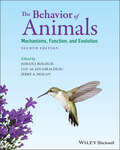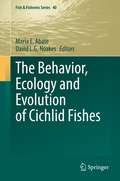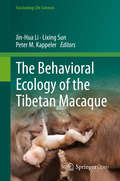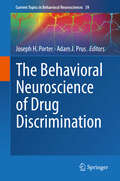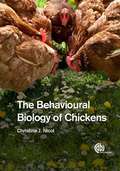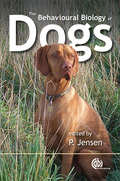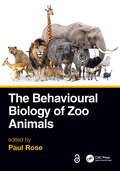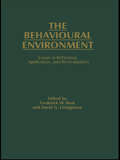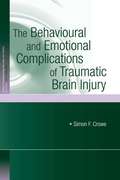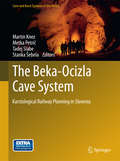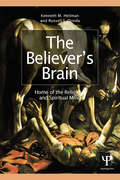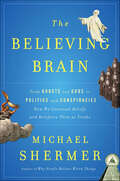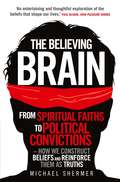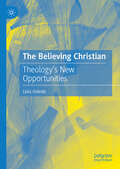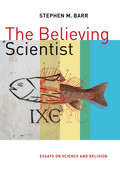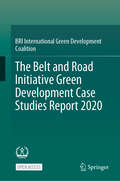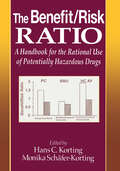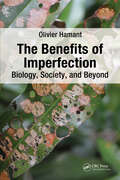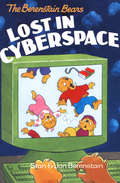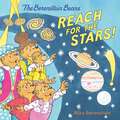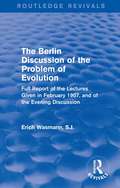- Table View
- List View
The Behavior of Animals: Mechanisms, Function, and Evolution
by Luc-Alain Giraldeau Jerry A. Hogan Johan J. BolhuisThe Behavior of Animals An updated view of animal behavior studies, featuring global experts The Behavior of Animals, Second Edition provides a broad overview of the current state of animal behavior studies with contributions from international experts. This edition includes new chapters on hormones and behavior, individuality, and human evolution. All chapters have been thoroughly revised and updated, and are supported by color illustrations, informative callouts, and accessible presentation of technical information. Provides an introduction to the study of animal behavior Looks at an extensive scope of topics- from perception, motivation and emotion, biological rhythms, and animal learning to animal cognition, communication, mate choice, and individuality. Explores the evolution of animal behavior including a critical evaluation of the assumption that human beings can be studied as if they were any other animal species. Students will benefit from an updated textbook in which a variety of contributors provide their expertise and global perspective in specialized areas
The Behavior of Texas Birds
by Kent RylanderWhether it's the sudden, plunging dives of Brown Pelicans, the singing and aerial displays of Northern Mockingbirds, or the communal nesting of Purple Martins, innate and learned behaviours are some of the most fascinating things to observe in Texas birds. Even casual birdwatchers eventually ask, ""why do they do that?"" while serious birders and ornithologists seek to understand all the behaviours involved in feeding, flying, mating, and rearing young. But until now, it has been hard to find this information in one handy source. In this comprehensive, yet easy-to-use book, Kent Rylander distils data from many sources to provide an authoritative guide to the behaviour of Texas birds. He begins by explaining the principles of animal behaviour and illustrating how they can be applied to interpreting bird behaviours in the field. The majority of the book is devoted to accounts of more than 400 species of birds that are most likely to be encountered by Texas birdwatchers. Each account describes such behaviours as feeding, courtship, parenting, and other behaviours that are significant for that species.
The Behavior, Ecology and Evolution of Cichlid Fishes (Fish & Fisheries Series #40)
by David L. G. Noakes Maria E. AbateThis volume constitutes the most recent and most comprehensive consideration of the largest family of bony fishes, the Cichlidae. This book offers an integrated perspective of cichlid fishes ranging from conservation of threatened species to management of cichlids as invasive species themselves. Long-standing models of taxonomy and systematics are subjected to the most recent applications and interpretations of molecular evidence and multivariate analyses; and cichlid adaptive radiations at different scales are elucidated. The incredible diversity of endemic cichlid species in African lakes is revisited as possible examples of sympatric speciation and as serious cases for management in complex anthropogenic environments. Extreme hydrology and bathymetry as driver of micro-allopatric speciation is explored in the African riverine hotspot of diversity of the lower Congo River. Dramatic new molecular evidence draws attention to the complex taxonomy and systematics of Neotropical cichlids including the crater lakes of Central America. Molecular genetics, genomics, imaging tools and field study techniques assess the roles of natural, sexual and kin selection in shaping cichlid traits and beyond. The complex behavioral adaptations of cichlids are considered from a number of sub-disciplines including sensory biology, neurobiology, development, and evolutionary ecology. Most importantly, this volume puts forth a wealth of new interpretations, explanatory hypotheses and proposals for practical management and applications that will shape the future for these remarkable fishes in nature as well as their use as models for the study of biology.
The Behavioral Biology and Conservation of Goitered Gazelles (Gazella subgutturosa)
by David BlankThis comprehensive and lavishly illustrated book summarizes all known information on the Goitered Gazelle (Gazella subgutturosa), one of the world's most endangered antelopes. It includes information on topics such as feeding ecology, behavior, vocalizations, parasites and diseases, and conservation. This research monograph will be of interest to professional researchers of ungulates, university staff, students, and naturalists.
The Behavioral Ecology of the Tibetan Macaque (Fascinating Life Sciences)
by Peter M. Kappeler Jin-Hua Li Lixing SunThis open access book summarizes the multi-disciplinary results of one of China’s main primatological research projects on the endemic Tibetan macaque (Macaca thibetana), which had continued for over 30 years, but which had never been reported on systematically. Dedicated to this exceptional Old World monkey, this book makes the work of Chinese primatologists on the social behavior, cooperation, culture, cognition, group dynamics, and emerging technologies in primate research accessible to the international scientific community.One of the most impressive Asian monkeys, and the largest member of its genus, the Tibetan macaque deserves to be better known. This volume goes a long way towards bringing this species into the spotlight with many excellent behavioral analyses from the field. - Frans de Waal, Professor of Psychology, Emory University, USA.Macaques matter. To understand primate patterns and trends, and to gain important insight into humanity, we need to augment and expand our engagement with the most successful and widespread primate genus aside from Homo. This volume focuses on the Tibetan macaque, a fascinating species with much to tell us about social behavior, physiology, complexity and the macaque knack for interfacing with humans. This book is doubly important for primatology in that beyond containing core information on this macaque species, it also reflects an effective integrated collaboration between Chinese scholars and a range of international colleagues—exactly the type of collaborative engagement primatology needs. This volume is a critical contribution to a global primatology. - Agustín Fuentes, Professor of Anthropology, University of Notre Dame, USA. I have many fond memories of my association with Mt. Huangshan research beginning in 1983, when together with Professor Qishan Wang we established this site. It is such a beautiful place and I miss it. It is gratifying to see how far research has progressed since we began work there, becoming more internationalized and very much a collaborative endeavor under the long-term direction of Professor Jin-Hua Li and colleagues. This book highlights the increased interest in this species, representing a variety of disciplines ranging from macro aspects of behavior, cognition and sociality, to micro aspects of microbes, parasites and disease, authored by a group of renowned Chinese and international primatologists. I applaud their efforts and expect more interesting work to come from this site in the years ahead. - Kazuo Wada, Professor Emeritus, Kyoto University, Japan.
The Behavioral Neuroscience of Drug Discrimination (Current Topics in Behavioral Neurosciences #39)
by Joseph H. Porter Adam J. PrusThe goal for this volume is to provide an up-to-date review of the discriminative stimulus properties of major psychoactive drug classes with an emphasis on how this paradigm enhances our understanding of these drugs and how these findings translate from animals to humans. The drug discrimination paradigm applies to both drugs of abuse and drugs for treating mental illnesses, and research from these studies has provided immense translational value for learning about the mechanisms responsible for drug effects in humans.
The Behavioural Biology of Chickens
by Christine NicolChickens are by far the world's most widely farmed animal, kept for both meat and egg production. They are at the centre of many debates regarding housing and production systems, causing significant interest in what lies behind chicken behaviour. This accessible book covers sensory biology, behavioural development, preferences and aversions, social behaviour, learning and cognition, behavioural issues in different systems and solutions for behavioural problems. Authored by an authority on chicken ethology, it brings together the fields of animal behaviour, neuroscience, psychology and epidemiology to provide a comprehensive understanding of chicken behaviour and help improve the lives of farmed chickens around the world.
The Behavioural Biology of Dogs
by Per JensenAs humans oldest domesticated animals, dogs serve as an excellent model for studying how mammal behavior and cognition have evolved. So states Jensen (biology, Linköping U., Sweden) in introducing 14 chapters intended for students in animal behavior or veterinary medicine. International researchers present up-to-date information on aspects of Caninae species diversity and behavior in evolutionary and social ecological contexts. General readers may find the sections treating dog personality, behavioral problems and their link to disease of interest. Lightly-illustrated chapters include references and further suggested reading.
The Behavioural Biology of Zoo Animals
by Paul Rose"Zoo animals" as a population are a diverse array of species from all around the globe. When managed in captivity, it is important that key aspects of natural ecology are factored into animal care, as well as considerations relating to welfare, life history and behavioural needs. The Behavioural Biology of Zoo Animals is the first book on captive animal behaviour and how this applies to welfare. The book enables all aspects of zoo husbandry and management (nutrition, enclosure design, handling and training, enrichment, population management) to be based on a sound knowledge of the species, its evolutionary history and its natural history. Chapters from expert authors cover a vast range of taxa, from primates and elephants to marine mammals and freshwater fish, to reptiles, birds and invertebrates. A final part looks to the future, considering animal health and wellbeing, the visitor experience and future visions for zoos and aquariums. For on-the-ground practitioners as well as students of zoo biology, animal science and welfare, this book provides an explanation of key areas of behavioural biology that are important to fulfilling the aims of the modern zoo (conservation, education, research and recreation). It explains how evidence from the wild can be implemented into captive care to support the wider aims of the zoo, shedding light on the evidence-based approaches applied to zoo biology and animal management. Chapter 3 is available to download Open Access on the www.taylorfrancis.com website.Aa Companion Website with additional resources is freely available for all at www.bbzabook.wordpress.com and you can follow the book on Instagram at @bbza_book.
The Behavioural Environment: Essays in Reflection, Application and Re-evaluation
by David N. Livingstone Frederick W. BoalPlacing human action and perception at the centre of the subject, this book considers the effects of mankind on the environment, drawing particularly from William Kirk's work on the behavioural environment model. Reviewing Kirk's original model in light of recent ideological debate and extensive new evidence, this collection of essays from leading names in the field shows that a behavioural approach is essential in understanding human geography and man's relationship with the ecological environment.
The Behavioural and Emotional Complications of Traumatic Brain Injury (Studies On Neuropsychology, Neurology And Cognition Ser.)
by Simon F. CroweIt is difficult to imagine what it must be like for someone following the personal crisis and catastrophe that ensues as a result of a serious traumatic brain injury (TBI). The individual is confronted with a huge range of alterations in his or her normal functioning, operating at the biological, psychological and social levels. All of these c
The Beka-Ocizla Cave System
by Martin Knez Metka Petrič Tadej Slabe Stanka ŠebelaA proposed railway on the 5th European Railway Corridor (Venice-Kiev) between the northern Adriatic ports of Koper (Slovenia) and Trieste (Italy) and the interior of Slovenia required extensive karstological studies and planning. This book contains the knowledge gained from these studies as well as further information on the regional karst surface and underground, the karst hydrogeology and the specific caves of the Beka-Ocizla cave system.
The Believer's Brain: Home of the Religious and Spiritual Mind
by Kenneth M. Heilman Russell S. DondaAbout 90% of people have faith in a supreme being, but our yearning for the divine, and whatever it promises, involves a large divergence in mental states and behaviors. Some adhere to doctrine, supplication, and fastidious religious practices; others have a strong sense they are part of something greater and more universal. However, all religious and spiritual paths are mediated by complex brain networks. When different areas of the brain are stimulated, a person can have a variety of experiences, but there is no specific ‘God spot’ where stimulation enhances religiosity or spirituality. Functional brain imaging shows that there are specific areas of the brain that ‘light up’ when subjects perform certain religious activities, but imaging only provides anatomic correlations, not functional explanations. The Believer's Brain takes a step beyond these singular methodologies, providing converging evidence from a variety study methods of how humans’ brain networks mediate different aspects of religious and spiritual beliefs, feelings, actions, and experiences. Although the book reveals how our brain is the home to the religious and spiritual mind, understanding this gift will not diminish our spirituality or our love or our belief in a supreme being, but will increase appreciation of the apparatus that mediates these mental states.
The Believing Brain: From Ghosts and Gods to Politics and Conspiracies—How We Construct Beliefs and Reinforce Them as Truths
by Michael Shermer“A wonderfully lucid, accessible, and wide-ranging account of the boundary between justified and unjustified belief.” —Sam Harris, New York Times–bestselling author of The Moral Landscape and The End of FaithIn this work synthesizing thirty years of research, psychologist, historian of science, and the world’s best-known skeptic Michael Shermer upends the traditional thinking about how humans form beliefs about the world. Simply put, beliefs come first and explanations for beliefs follow. The brain, Shermer argues, is a belief engine. From sensory data flowing in through the senses, the brain naturally begins to look for and find patterns, and then infuses those patterns with meaning. Our brains connect the dots of our world into meaningful patterns that explain why things happen, and these patterns become beliefs. Once beliefs are formed the brain begins to look for and find confirmatory evidence in support of those beliefs, which accelerates the process of reinforcing them, and round and round the process goes in a positive-feedback loop of belief confirmation. Shermer outlines the numerous cognitive tools our brains engage to reinforce our beliefs as truths.Interlaced with his theory of belief, Shermer provides countless real-world examples of how this process operates, from politics, economics, and religion to conspiracy theories, the supernatural, and the paranormal. Ultimately, he demonstrates why science is the best tool ever devised to determine whether or not a belief matches reality.“A must read for everyone who wonders why religious and political beliefs are so rigid and polarized—or why the other side is always wrong, but somehow doesn’t see it.” —Dr. Leonard Mlodinow, physicist and author of The Drunkard’s Walk and The Grand Design (with Stephen Hawking)
The Believing Brain: From Spiritual Faiths to Political Convictions – How We Construct Beliefs and Reinforce Them as Truths
by Michael ShermerSynthesizing thirty years of research, psychologist and science historian, Michael Shermer upends the traditional thinking about how humans form beliefs about the world. Simply put, beliefs come first and explanations for beliefs follow. The brain, Shermer argues, is a belief engine. Using sensory data that flow in through the senses, the brain naturally looks for and finds patterns - and then infuses those patterns with meaning, forming beliefs. Once beliefs are formed, our brains subconsciously seek out confirmatory evidence in support of those beliefs, which accelerates the process of reinforcing them, and round and round the process goes in a positive-feedback loop.In The Believing Brain, Shermer provides countless real-world examples of how this process operates, from politics, economics, and religion to conspiracy theories, the supernatural, and the paranormal. Ultimately, he demonstrates why science is the best tool ever devised to determine whether or not our belief matches reality.
The Believing Christian: Theology’s New Opportunities
by Lluis OviedoThis book offers an updated version of the credibility treatise as part of a fundamental theology. Focusing on practical arguments that make Christian faith interesting and positive for improving the quality of one's life and relationships, it shows how the Christian faith is beneficial for the individual, the family and society as a whole. The book draws from recent literature on religious coping; religion and resilience; religion and well-being; religion and human flourishing to make the case for Christian faith as a good choice. This book also addresses the most difficult challenges facing the Christian faith in our time, such as a secularising environments, struggles with science, a troubled past, or simply the problem of making faith a convincing life style. It's an important read for scholars of theology, faith, and non-belief.
The Believing Scientist: Essays on Science and Religion
by Stephen BarrElegant writings by a cutting-edge research scientist defending traditional theological and philosophical positions Both an accomplished theoretical physicist and a faithful Catholic, Stephen Barr in this book addresses a wide range of questions about the relationship between science and religion, providing a beautiful picture of how they can coexist in harmony. In his first essay, "Retelling the Story of Science," Barr challenges the widely held idea that there is an inherent conflict between science and religion. He goes on to analyze such topics as the quantum creation of universes from nothing, the multiverse, the Intelligent Design movement, and the implications of neuroscience for the reality of the soul. Including reviews of highly influential books by such figures as Edward O. Wilson, Richard Dawkins, Stephen Jay Gould, Francis S. Collins, Michael Behe, and Thomas Nagel, The Believing Scientist helpfully engages pressing questions that often vex religious believers who wish to engage with the world of science.
The Belt and Road Initiative Green Development Case Studies Report 2020
by BRI International Green DevelopmentThis is an Open Access book. In accordance with the 2030 Agenda for Sustainable Development, it showcases 17 projects under the framework of Belt & Road Initiative (BRI). These projects cover ninefields, namely, biodiversity and ecosystem, clean energy, clean water, sustainable transportation, solid waste treatment, sustainable consumption and production, green buildings, sustainable foodproduction and corporate social responsibility. Aiming at achieving green development, these projects, in their implementation, adhere to the concept of ecological civilization, combine China’s strict environmental protection systems and international standards, and take various measures of environmental protection based on the conditions of the local environment. These measures include joint efforts with local governments, businesses and communities, optimizating of design and construction plans, strict controling over different types of pollutants, and in situ conservation of species and ecosystems.The experience and practice of these 13 projects set an example for the latecomers.
The Ben Franklin Book of Easy and Incredible Experiments: A Franklin Institute Science Museum Book
by Franklin Institute Science MuseumLearn about science the same way Ben Franklin did--by performing incredible experiments Ben Franklin, the famous patriot and signer of the Declaration of Independence, was also America's first great scientist.
The Bench Grafter's Handbook: Principles & Practice
by Brian E. HumphreyContaining 500 full color photographs and illustrations, The Bench Grafter’s Handbook: Principles and Practice presents exhaustive information on all aspects of bench grafting. It details requirements of more than 200 temperate woody plant genera, covering over 2,000 species and cultivars including important ornamental, temperate fruit, and nut crops. The book explains the principles and practices of bench grafting, new procedures to enhance grafting success, and recommendations for further scientific investigation. Practical issues to aid professionals and the beginner, include detailed accounts, supported by pictures and diagrams, of the main grafting methods, knifesmanship techniques, and methods of training. Provision and design, now and for the future, of suitable structures, grafting facilities, and equipment, to provide ideal controlled environments for grafts, are described. The book describes major grafting systems, sub-cold, cold, warm, supported warm, hot-pipe, and other grafting strategies. It provides details of health and safety issues; work stations, seat design, lighting levels; recorded output figures for various types of graft; grafting knives and tools; and methods of sharpening by hand and machine. Features: Comprehensive description, pictures, and diagrams of how to learn and utilize important grafting methods. Detailed information and scientific principles behind the selection, specification, and choice of the main graft components – the rootstock and scion. Scientific principles and practicalities of providing optimal plant material, equipment, facilities and environmental conditions for graft union development including addressing the problems of graft incompatibility. Discussion of the actual and potential role of bench grafting in woody plant conservation with suggestions for new initiatives. This book is intended for use by nurserymen; those involved in the upkeep of extensive plant collections; conservationists; plant scientists; lecturers in horticulture; horticultural students; and amateurs with an interest in grafting.
The Benefit/Risk Ratio: A Handbook for the Rational Use of Potentially Hazardous Drugs
by Hans C. Korting M. Schafer-KortingThe use of drugs as remedies for various types of diseases has a long tradition; however, it has only been recently recognized that the value of any given compound must be evaluated in light of its benefit to risk ratio. When prescribing drugs, physicians must look at the big picture of the drug's benefits in relation to its side effects and possib
The Benefits of Imperfection: Biology, Society, and Beyond
by Olivier HamantThe cult of performance leads our society to emphasise the values of success and continuous optimisation in all areas. Slowness, redundancy and randomness are therefore negatively perceived. Olivier Hamant, in his book, reclaims them by his knowledge of biological processes.What can we learn from life sciences? While some biological mechanisms certainly boast formidable efficiency, recent advances instead highlight the fundamental role of errors, incoherence or slowness in the robustness of living organisms. Should life be considered suboptimal? To what extent could suboptimality become a counter-model to the credo of performance and control in the Anthropocene?In the face of pessimistic observations and environmental alerts, the author outlines solutions for a future that is viable and reconciled with nature.Key Features: Solidly documents with a grounding in scientific facts focusing on solutions Explores a pragmatic way towards robustness, moving the debate beyond performance, technolatry or degrowth Responds to eco-anxiety by providing an engaging and viable way forward
The Berenstain Bears Lost in Cyberspace (I Can Read!)
by Stan Berenstain Jan BerenstainComputers in the classroom send the Bear Country cubs into cyberspace <P><P>The cubs of Bear Country School are in for a real surprise when Squire Grizzly gives each student a computer. With the discovery of the Internet, everyone start to lose focus and forget to do their schoolwork. <P><P>Teacher Bob struggles to bring the pupils out of cyberspace and back to Beartown--and teach them the importance of real-life interaction before it's too late.
The Berenstain Bears Reach for the Stars! (Berenstain Bears)
by Mike BerenstainFeaturing over a dozen cosmic facts! The Berenstain Bears learn about the solar system and what exists beyond the stars in this funny and educational addition to the New York Times bestselling series.After watching a science fiction TV show, Brother and Sister Bear are bursting with questions about outer space! Luckily, Teacher Jane has some answers. From the Solar System to the Milky Way to the edge of space itself, Brother and Sister will travel across the stars and learn about the wonders of our universe.
The Berlin Discussion of the Problem of Evolution: Full Report of the Lectures Given in February 1907, and of the Evening Discussion
by Erich Wasmann, S.J.First published in 1909, this book collects the author’s lectures on the ‘problem of evolution’ and the resultant debate. The first considers the validity of the Theory of Evolution and whether it is in opposition to the Christian view of creation. The second examines the assertion that evolution harmonises only with Monism rather than Theism and which of the two views is preferable. It also looks at the popular identification of Darwinism with evolution, if it is scientific and the results this leads to. The third looks at man’s position in the problem of evolution — whether we are bound to bring in considerations higher than the zoological — and the evidence for our descent from ‘brutes’.
